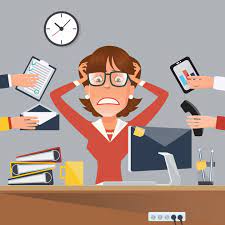

Workplace stress—the not-so-silent saboteur that is constantly lurking in the background of office life.
From tight deadlines and micromanaging bosses to never-ending email chains, workplace stress does not just mess with your mind; it has a way of sneaking into your physical posture, too.
If you have ever felt your neck slowly morphing into a crane’s as you hunch over your keyboard, you are not alone.
Today, we are diving into how and why all that office tension leads to some seriously poor neck posture.
Get ready to explore everything from the physiological reasons behind stress-induced neck pain to real-life examples and scientific research that explain why workplace stress has your neck screaming, “Help!”
In This Article:
- The Science Behind Stress and Muscle Tension
- Why Office Stress Targets Your Neck
- The Role of Muscle Memory in Poor Posture
- How Your Office Setup Plays a Role
- Real-Life Example: Meet Sarah, the Stressed Accountant
- The Impact of Psychological Stress on Physical Posture
- The Link Between Stress Hormones and Muscle Tightness
- When Desk Jobs Turn into Neck Nightmares
- Conclusion: Acknowledging the Connection Without a Fix
The Science Behind Stress and Muscle Tension
Let’s start with some science because, hey, knowledge is power.
Stress is a natural response designed to keep us safe from danger.
When you perceive a threat—whether it is a lion or a looming project deadline—your body releases stress hormones like cortisol and adrenaline.
These hormones prepare you for the classic “fight or flight” response by tightening muscles and increasing alertness.
But what happens when that response does not have a clear endpoint, and you are just chronically stressed?
According to research published in The Journal of Applied Physiology, chronic stress causes sustained muscle tension, particularly in the neck and upper back.
This muscle bracing is part of your body’s way of gearing up for action, but when there’s no actual physical threat, your neck muscles are left in a constant state of tension.
Over time, this not only leads to discomfort but also begins to affect your posture and spinal alignment.
Why Office Stress Targets Your Neck
“Why the neck?” you might be asking.
The neck, or cervical spine, is one of the most vulnerable parts of your musculoskeletal system.
The muscles surrounding your neck are relatively small and weak compared to those in your lower back.
When stress takes hold, these muscles bear the brunt of the tension, leading to poor neck posture over time.
The neck is also a central support for your head, which weighs roughly as much as a bowling ball.
When you are stressed, you tend to hunch or crane your neck, making it work overtime to support your head.
A study from Ergonomics suggests that sitting for long hours, combined with stress, increases the likelihood of adopting a forward head posture.
It is as if your neck is trying to escape the chaos of your work environment, stretching forward like a turtle out of its shell.
Over weeks, months, or even years, this leads to structural changes in your neck that are hard to reverse.
The Role of Muscle Memory in Poor Posture
Ever wondered why you slouch even when you do not feel stressed?
Enter muscle memory.
If your body stays in a tense, hunched position for extended periods, your muscles adapt to that posture, making it your new normal.
This phenomenon is known as muscle memory, where your body essentially “learns” the bad posture and assumes it automatically, even when you are not consciously stressed.
Physical Therapy Journal notes that repetitive stress-induced muscle tension leads to permanent changes in muscle structure.
This adaptation means that even on a calm day, your neck and shoulders may still feel tight.
The longer you maintain poor posture, the more difficult it becomes to correct, as your muscles become “trained” to hold that position.
Think of it as your body being stuck on autopilot in the wrong position, thanks to years of stress and repetitive strain.
How Your Office Setup Plays a Role?
Sure, stress has a huge part to play, but let’s not forget about that less-than-ideal office setup.
Low desks, poorly adjusted monitors, and unsupportive chairs make it nearly impossible to maintain good posture.
When you are stressed, you are less likely to be mindful of your body alignment, further exacerbating the issue.
The connection between poor ergonomics and stress-induced posture problems is backed by studies from The Journal of Occupational Health Psychology, which found that uncomfortable workstations increase muscle strain and stress levels.
“What is the best posture for degenerative disc disease?” you might ask.
It is similar to what is recommended for avoiding stress-related neck strain: sitting up straight with your monitor at eye level and feet flat on the floor.
Unfortunately, most of us do not have the perfect ergonomic setup, and the combination of stress and a bad office layout creates a double whammy for neck problems.
Time to Meet Sarah, the Stressed Accountant
Let’s talk about Sarah. Sarah is a 32-year-old accountant who works 10-hour days filled with tight deadlines and demanding clients.
Her neck pain started as a dull ache but eventually became a stabbing pain that would not go away.
Her physical therapist explained that her forward head posture was likely due to chronic workplace stress.
Her body had adapted to the tension by holding her neck and shoulders in a protective, hunched position.
Sarah’s story is a common one and serves as a reminder of how psychological stress manifests physically, often in the neck and shoulders.
Even after her work hours, she found it hard to relax, and the muscle tension remained.
Her experience highlights how mental stress leads to physical symptoms, which, if ignored, can turn into long-term issues.
The Impact of Psychological Stress on Physical Posture
The mind-body connection is real, and nowhere is this more evident than in the way stress impacts posture.
Psychological stress leads to muscle bracing—a term used to describe how your body prepares for a physical reaction to stress.
Your muscles tighten up, and your body becomes rigid, often resulting in poor posture.
The Journal of Psychosomatic Research found that people under chronic stress are more likely to experience musculoskeletal pain, especially in the neck and upper back.
Your body’s stress response is designed to be temporary, but in today’s work culture, stress is a constant companion.
This means that muscle bracing becomes chronic, and over time, the neck muscles weaken or shorten.
The cycle of tension and poor neck posture then feeds into itself, making it even harder to break free from the discomfort.
The Link Between Stress Hormones and Muscle Tightness
Let’s talk hormones.
When cortisol floods your system, it has a cascade effect on your muscles, making them tighten up and become less flexible.
This makes it harder to maintain proper posture, especially in the neck area.
A study from Endocrine Reviews highlights how elevated cortisol levels are directly linked to increased muscle tension (such as stiff calf muscles), which, over time, becomes chronic.
Adrenaline, another stress hormone, also plays a role in muscle tightness.
It is like your body is constantly on high alert, ready for action, but the action never comes.
This hormone soup does not just make you feel frazzled; it impacts your muscle elasticity and joint mobility.
As a result, maintaining a neutral head position becomes a herculean task, and poor neck posture becomes your default.
When Desk Jobs Turn into Neck Nightmares
You would think that a desk job would be easy on the body.
But between endless hours of screen time, stress, and poor ergonomics, it is actually a recipe for poor posture.
People often wonder, “Can poor posture cause degenerative disc disease?”
While poor posture itself is not the direct cause, it certainly speeds up the degeneration process, making you more prone to conditions like degenerative disc disease.
“What to avoid with degenerative disc disease C5-C6?”
Heavy lifting, poor posture, and prolonged sitting are top culprits.
The more stress you experience, the less likely you are to take breaks or adjust your posture, and this creates a vicious cycle that only exacerbates your neck issues.
Acknowledging the Connection Without a Fix
So, what have we learned?
To be productive at your workplace, you need to learn how fix your bad neck posture at home.
Workplace stress does not just live in your mind; it takes up residence in your neck muscles, causing poor posture and long-term issues.
The next time you feel stress creeping in, take a moment to notice your posture. While we won’t offer solutions here (that’s for another day), understanding the connection between workplace stress and neck posture is the first step in making changes.
After all, if we cannot escape workplace stress entirely, we might as well learn how to manage its physical consequences a bit better.
References:


